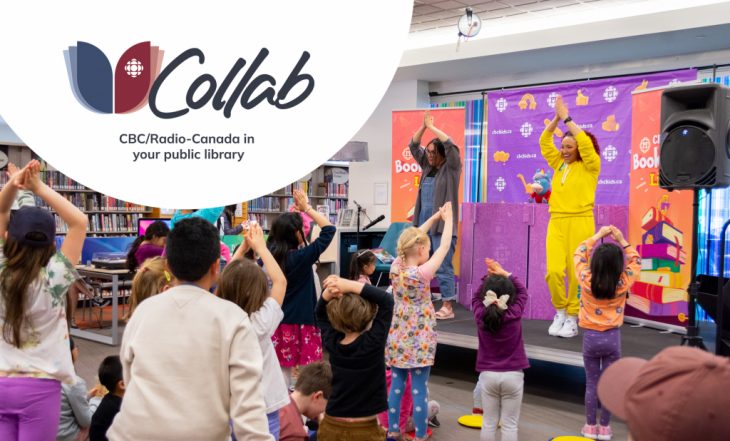
Never before have Canadians had access to so much content — movies, TV shows, news, documentaries, video games and hilarious clips — from around the globe. Netflix, Amazon, Disney+, YouTube, Facebook, TikTok — an endless list of services and apps bringing the entire world to our fingertips.
Yet many of us live in this digital world alone, isolated. So where do we meet people from our neighbourhood? There is a place: the public library. Today’s library is not just a place to borrow books — it’s a community hub, a multimedia studio and a place to learn languages and new skills. And it’s also where CBC/Radio-Canada is connecting with Canadians.
Collab — CBC/Radio-Canada in your public library — has been introducing newcomers, younger audiences and other hard-to-reach communities to all that CBC/Radio-Canada has to offer since 2021. It’s our way to engage more deeply with Canadians, where they are, where they live. After all, proximity to our audiences is the strength of any public service media.
The public broadcaster has a lot in common with public libraries. We share a common mission to serve all Canadians, and in recent years each institution has been evolving to reach Canadians where they are, both online and in the physical world. With 3,000 branches across Canada located near 90% of the population, libraries offer unmatched proximity to communities from coast to coast to coast. We know that newcomers, lower income Canadians, youth, and First Nations, Inuit and Métis are the hardest to reach audiences. Many did not grow up with us and others simply do not know us. Yet many from these communities do know their local library.
Collab is bringing communities together in incredible ways. Earlier this year, CBC opened a new permanent bureau in Lethbridge, Alberta. To celebrate, CBC Calgary partnered with the Lethbridge Public Library to welcome more than 2,300 residents to a two-day event with live radio broadcasts, a comedy show, Indigenous craft workshops and so much more. This is your public broadcaster at work, in the community, where it matters.
To date, we have forged nearly 50 partnerships with public libraries in 12 provinces and territories, in communities from Prince Rupert to Puvirnituq to Happy Valley-Goose Bay. Newcomer associations, mayors and local media are among those who have gotten involved to expand the reach and impact of Collab.
Early on, we learned that library visitors are eager for high-quality, Canadian digital resources for both entertainment and information. The kind of entertainment and information that CBC and Radio-Canada have in abundance! So, we developed a new platform to offer all our content to library patrons in a single digital portal: CBC Corner and L’espace Radio-Canada.
CBC Corner and L’espace Radio-Canada are now available in more than 750 library branches, reaching a potential 3.7 million library cardholders with a wealth of CBC and Radio-Canada content like CBC Kids News and MAJ, our news services for kids, CBC Indigenous and Espaces autochtones, and our English- and French-language learning app Mauril. We are also opening the platform to other cultural institutions like Ingenium, the Canadian Museum of Nature and the Canada Council for the Arts to contribute their content as well.
Thousands of Canadians now access this one-of-a-kind portal each month. For newcomers in particular, this is often their first exposure to CBC/Radio-Canada. This is exactly why Collab matters — it brings the public broadcaster to people who may not otherwise know what it offers them.
Albert Einstein once said, “The only thing that you absolutely have to know is the location of the library.” That’s still true today, and whether Canadians are accessing their library at a physical location or online from the comfort of their home, they can find their public broadcaster there, too. Just another example of how your public broadcaster isn’t just a broadcaster — it’s a platform for community building, connections, and convening conversations.
This is part 2 in a series of Cartt-exclusive commentary pieces from Catherine Tait, head of the public broadcaster. In it, Tait shares her thoughts on how the national public broadcaster plays a central role in Canada’s media industry. Click here for Part 1.



